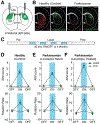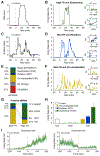Aberrant Striatal Activity in Parkinsonism and Levodopa-Induced Dyskinesia
- PMID: 29924988
- PMCID: PMC6407866
- DOI: 10.1016/j.celrep.2018.05.059
Aberrant Striatal Activity in Parkinsonism and Levodopa-Induced Dyskinesia
Abstract
Action selection relies on the coordinated activity of striatal direct and indirect pathway medium spiny neurons (dMSNs and iMSNs, respectively). Loss of dopamine in Parkinson's disease is thought to disrupt this balance. While dopamine replacement with levodopa may restore normal function, the development of involuntary movements (levodopa-induced dyskinesia [LID]) limits therapy. How chronic dopamine loss and replacement with levodopa modulate the firing of identified MSNs in behaving animals is unknown. Using optogenetically labeled striatal single-unit recordings, we assess circuit dysfunction in parkinsonism and LID. Counter to current models, we found that following dopamine depletion, iMSN firing was elevated only during periods of immobility, while dMSN firing was dramatically and persistently reduced. Most notably, we identified a subpopulation of dMSNs with abnormally high levodopa-evoked firing rates, which correlated specifically with dyskinesia. These findings provide key insights into the circuit mechanisms underlying parkinsonism and LID, with implications for developing targeted therapies.
Keywords: Parkinson’s disease; basal ganglia; dopamine; dyskinesia; electrophysiology; levodopa; optogenetics; striatum.
Copyright © 2018 The Authors. Published by Elsevier Inc. All rights reserved.
Conflict of interest statement
Declaration of Interests
The authors declare no competing interests.
Figures




Similar articles
-
Excessive firing of dyskinesia-associated striatal direct pathway neurons is gated by dopamine and excitatory synaptic input.Cell Rep. 2024 Aug 27;43(8):114483. doi: 10.1016/j.celrep.2024.114483. Epub 2024 Jul 17. Cell Rep. 2024. PMID: 39024096 Free PMC article.
-
L-DOPA treatment selectively restores spine density in dopamine receptor D2-expressing projection neurons in dyskinetic mice.Biol Psychiatry. 2014 May 1;75(9):711-22. doi: 10.1016/j.biopsych.2013.05.006. Epub 2013 Jun 13. Biol Psychiatry. 2014. PMID: 23769604
-
A Subpopulation of Striatal Neurons Mediates Levodopa-Induced Dyskinesia.Neuron. 2018 Feb 21;97(4):787-795.e6. doi: 10.1016/j.neuron.2018.01.017. Epub 2018 Feb 1. Neuron. 2018. PMID: 29398356 Free PMC article.
-
Parkinson's disease--opportunities for novel therapeutics to reduce the problems of levodopa therapy.Prog Brain Res. 2008;172:479-94. doi: 10.1016/S0079-6123(08)00923-0. Prog Brain Res. 2008. PMID: 18772047 Review.
-
Dopaminergic modulation of striatal function and Parkinson's disease.J Neural Transm (Vienna). 2019 Apr;126(4):411-422. doi: 10.1007/s00702-019-01997-y. Epub 2019 Apr 1. J Neural Transm (Vienna). 2019. PMID: 30937538 Free PMC article. Review.
Cited by
-
Abnormal Cortico-Basal Ganglia Neurotransmission in a Mouse Model of l-DOPA-Induced Dyskinesia.J Neurosci. 2021 Mar 24;41(12):2668-2683. doi: 10.1523/JNEUROSCI.0267-20.2020. Epub 2021 Feb 9. J Neurosci. 2021. PMID: 33563724 Free PMC article.
-
A competitive model for striatal action selection.Brain Res. 2019 Jun 15;1713:70-79. doi: 10.1016/j.brainres.2018.10.009. Epub 2018 Oct 6. Brain Res. 2019. PMID: 30300636 Free PMC article. Review.
-
Excessive firing of dyskinesia-associated striatal direct pathway neurons is gated by dopamine and excitatory synaptic input.Cell Rep. 2024 Aug 27;43(8):114483. doi: 10.1016/j.celrep.2024.114483. Epub 2024 Jul 17. Cell Rep. 2024. PMID: 39024096 Free PMC article.
-
The Signaling and Pharmacology of the Dopamine D1 Receptor.Front Cell Neurosci. 2022 Jan 17;15:806618. doi: 10.3389/fncel.2021.806618. eCollection 2021. Front Cell Neurosci. 2022. PMID: 35110997 Free PMC article.
-
Regulation of neuronal autophagy and the implications in neurodegenerative diseases.Neurobiol Dis. 2022 Jan;162:105582. doi: 10.1016/j.nbd.2021.105582. Epub 2021 Dec 7. Neurobiol Dis. 2022. PMID: 34890791 Free PMC article. Review.
References
-
- Ahlskog JE, and Muenter MD (2001). Frequency of levodopa-related dyskinesias and motor fluctuations as estimated from the cumulative literature. Mov. Disord. Off. J. Mov. Disord. Soc 16, 448–458. - PubMed
-
- Albin RL, Young AB, and Penney JB (1989). The functional anatomy of basal ganglia disorders. Trends Neurosci 12, 366–375. - PubMed
-
- Bergman H, Wichmann T, Karmon B, and DeLong MR (1994). The primate subthalamic nucleus. II. Neuronal activity in the MPTP model of parkinsonism. J. Neurophysiol 72, 507–520. - PubMed
MeSH terms
Substances
Grants and funding
LinkOut - more resources
Full Text Sources
Other Literature Sources
Molecular Biology Databases

